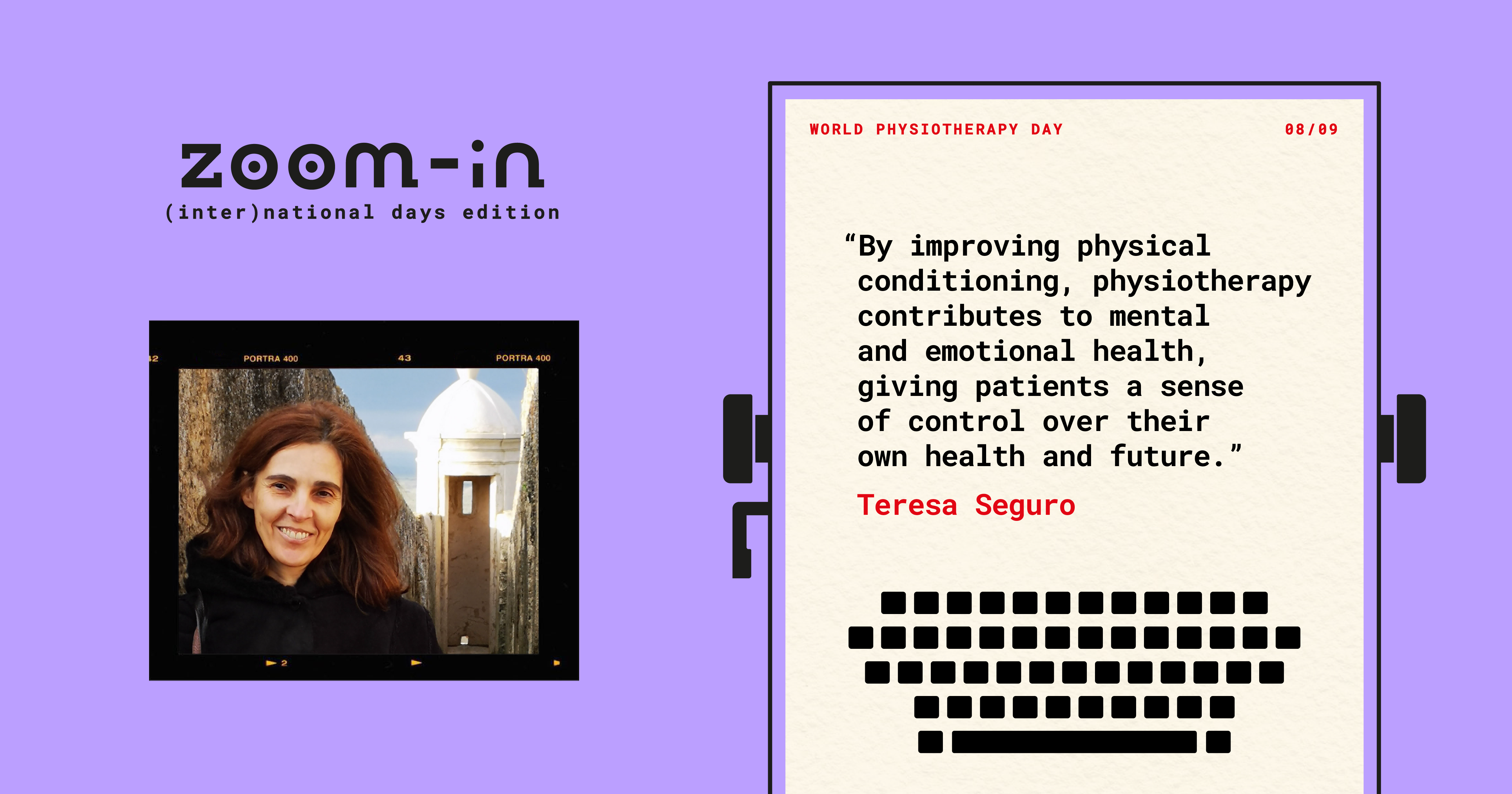World Physiotherapy Day has been celebrated since 1996, but 8 September was chosen as the date because this was when World Physiotherapy (a global collective of Physiotherapists) was founded in 1951.
The day marks the unity and solidarity of the global physiotherapy community. It is also an opportunity to recognise the work that physiotherapists do for their patients and community.
Teresa Seguro is a physiotherapist with a professional career in the cardiorespiratory field for over 30 years, working with patients in acute and chronic settings, with extensive experience in pre- and post-operative intervention and having attended several national and international courses in respiratory rehabilitation.Teresa currently coordinates the Physiotherapy Team at the Champalimaud Foundation, where the focus is centred exclusively on inpatient rehabilitation. In this Zoom-In, Teresa reveals how the Physiotherapy Team is always committed to improving continuity of care, while recognising the importance of developing a project aimed at optimising the preoperative condition of cancer patients.
September 8th is World Physiotherapy Day, but what role does physiotherapy have in cancer treatment?
Physiotherapy plays an important role in oncological disease, highlighting the contribution in the control of symptoms such as pain, dyspnea, fatigue and muscle weakness, caused by the disease itself as well as any surgical treatment, chemotherapy and/or radiotherapy. The gains obtained in terms of motor function can contribute to reducing anxiety and increasing the feeling of well-being. The treatment plan is personalised, always taking into account the specific needs of the patient and the stage of the disease. Physiotherapy not only contributes to physical improvement, but also to the mental and emotional strength of patients, enabling them to face cancer with more confidence and resilience.
It is easy to imagine that somebody who has recently been diagnosed with cancer, or has just had an operation, may not feel that physiotherapy is a priority. What would you say to those people?
In general, there is a belief among the population that, following an illness or during a surgical procedure, the best thing to do is to rest. Understandably, the side effects of treatment, the emotional suffering underlying the implications of the disease, or even the lack of information on this matter can contribute to this belief.
Therefore, it is up to the physiotherapist to highlight the benefits that physiotherapy can offer the patient. These include: reduction of symptoms such as pain, fatigue, respiratory discomfort; improvement in the feeling of well-being; increased mobility and muscle strength - all of which may allow for earlier discharge and faster recovery. A physiotherapist can also offer guidance, advice and assurance.
Furthermore, as cancer is increasingly considered a chronic disease, physiotherapy plays an important role in improving the patient's quality of life. It can help control and manage the side effects of long-term treatments, as mentioned earlier, but it can also offer guidance, advice and assurance. Education, information and availability to clear up any doubts all help to improve self-esteem, restore routines, facilitate a return to professional and social life and, above all, promote a feeling of normality.
By improving physical conditioning, physiotherapy contributes to mental and emotional health, giving patients a sense of control over their own health and future.
Are there any new treatments or techniques that you would like to implement as part of the physiotherapy programme?
At the moment, physiotherapy largely accompanies patients during hospitalisation in a post-surgical context, supported by the Advanced Recovery Programme (PRA), and in some acute conditions. However, it is well-known that healthier cardiorespiratory conditions contribute to surgical success, as well as reducing comorbidities and minimising the time a patient has to remain in hospital.
Bear in mind that the patient may be dealing with their recent diagnosis, ongoing treatment, the presence of preexisting unhealthy lifestyle habits, and even the fear of the unknown - all of which can mean that regular exercise is not at the forefront of their thinking before surgery.
This is why the Physiotherapy Team is intent on implementing a preoperative evaluation consultation, to optimise the patient's condition before surgical intervention, to be adapted and continued afterwards. An exercise plan could be made available that the patient would be able to maintain autonomously at home. These results could be compared with the evaluations carried out in the postoperative period. Creating a scenario where the patient is in as healthy a position as possible before and after treatment is our paramount objective.
Is there any key message that you would like to share about the use of physiotherapy in a cancer setting?
Simply - cancer survivors who practise physical exercise decrease the likelihood of disease recurrence, relative to those who don’t.
In general, cancer survivors tend to be less active than those who have never suffered with the disease, and it is important to note that the practice of exercise often decreases substantially after diagnosis, and this tendency is common even for people who already had regular exercise as part of their day-to-day routine.
To encourage cancer patients and survivors to stick to their exercise plans, a good understanding of the incentives and barriers is necessary, as well as the application of creative strategies for behavioural modification. The role of the physiotherapist is fundamental, because they can step in and support the patient at all stages of the process.
The practice of physical activity can be seen as an opportunity for the patient to gain control over his health, feeling like an active element in the fight against the disease and in preventing its recurrence.
Edited by John Lee, Content Developer of the Champalimaud Foundation Communication, Events and Outreach team.



